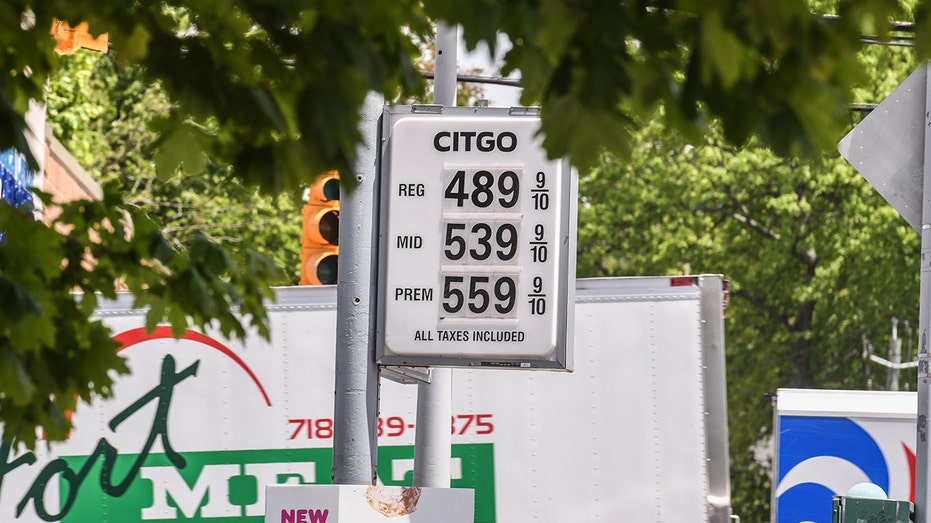What is stagflation? Why economists are worrying about a 1970s-style catastrophe
Larry Summers has warned the Fed is setting the table for stagflation and a major recession
Fed’s going to let inflation ‘run a little longer’ than expected: Expert
Expert trader Scott Shellady and Fidelity Investments' John Gagliardi discuss the Fed raising rates and how it will impact the economy.
Soaring consumer prices, supply chain shocks, rising energy costs and a hawkish Federal Reserve determined to bring inflation under control: These are the worrisome attributes of the U.S. economy that have some experts sounding the alarm over a possible return to 1970s-style "stagflation."
Stagflation is the combination of economic stagnation and high inflation, characterized by soaring consumer prices as well as high unemployment.
RUSSIA INVADES UKRAINE: LIVE UPDATES
The phenomenon ravaged the U.S. economy in the 1970s and early 1980s, as spiking oil prices, rising unemployment and easy monetary policy pushed the consumer price index as high as 14.8% in 1980, forcing Fed policymakers to raise interest rates to nearly 20% that year.
A telltale sign, and consequence, of stagflation is rising energy prices, according to many economists, who believe it occurs when a sudden increase in the cost of oil reduces an economy's productive capacity. For instance, in 1973, the Organization of Petroleum Exporting Countries imposed an embargo on oil supplies to the U.S. over its support for Israel.
The onset of the embargo exacerbated an upward spiral in oil prices, with the price per barrel doubling and then quadrupling. Rising oil costs imposed sky-high costs on consumers, who were forced to confront long lines at gas stations and rationing measures like "odd-even" purchases by license place number.
POWELL SAYS FED COULD RAISE INTEREST RATES FASTER TO COMBAT INFLATION
It was a major shock for an economy that had become reliant on cheap, foreign oil.
Although the crisis seemed to fade with the removal of the oil embargo in 1974, the relief was temporary: The Iranian revolution brought on a second wave of dramatically high prices in 1978-1979.
Some economists believe the U.S. economy is showcasing signs of "stagflation" today, after the Russian invasion of Ukraine sent oil prices soaring. Although gas prices moderated slightly in April, they have returned – and surpassed – the highs recorded in March.
The average price for a gallon of gas was at $4.59 nationwide on Friday, according to AAA, up from $3.04 one year ago. It marks the steepest price for gasoline on record; until the recent inflation spike, prices had not topped $4 a gallon nationally since 2008. Some Americans are paying even more for fuel: In parts of California, for instance, prices are as high as $7 a gallon.
Americans are already grappling with once-in-a-generation inflation: The Labor Department reported earlier this month that prices jumped 8.3% in April from the previous year. While that is down slightly from the 40-year high recorded in March, it still shows that consumer prices are extraordinarily high and underscores the strength of inflationary pressures in the economy.
Rapidly rising consumer prices have forced the Federal Reserve to chart an aggressive course to normalizing policy, with policymakers unanimously approving a steeper, half-point rate hike in May – the first such move in two decades. Fed Chairman Jerome Powell has signaled that similarly sized moves are on the table at future meetings in June and July.

Larry Summers, president emeritus of Harvard University, speaks during a discussion on "A Reform Agenda for Europe's Leaders" during the World Bank/IMF annual meetings in Washington Oct. 9, 2014. (REUTERS/Joshua Roberts / Reuters Photos)
Former Treasury Secretary Larry Summers, a prominent inflation hawk, has accused the Fed of misinterpreting the inflation spike and waiting too long to take action to quell the price spike. By doing so, Summers wrote in a recent Washington Post op-ed, the central bank has paved the way toward "stagflation."
"I believe the Fed has not internalized the magnitude of its errors over the past year, is operating with an inappropriate and dangerous framework, and needs to take far stronger action to support price stability than appears likely," Summers wrote. "The Fed’s current policy trajectory is likely to lead to stagflation, with average unemployment and inflation both averaging over 5 percent over the next few years — and ultimately to a major recession."
Summers it not alone in his opinion.
GET FOX BUSINESS ON THE GO BY CLICKING HERE
Former Fed Chairman Ben Bernanke has likewise accused the current U.S. central bank leaders of waiting too long to address surging inflation and has warned the economy faces a period of stagflation for the first time since the 1970s as a result. His comments marked a rare example of a former Fed chair criticizing the U.S. central bank.
"Even under the benign scenario, we should have a slowing economy," Bernanke told the New York Times during a recent interview. "And inflation’s still too high but coming down. So there should be a period in the next year or two where growth is low, unemployment is at least up a little bit and inflation is still high. So you could call that stagflation."

Fuel prices at a gas station in New York, U.S., on Tuesday, May 17, 2022. From record prices to blowout spreads and falling stockpiles, a handful of financial and physical indicators are pointing to expensive and possibly tighter gasoline markets acr (Photographer: Stephanie Keith/Bloomberg via Getty Images / Getty Images)
Danielle DiMartino Booth, the CEO and chief strategist of Quill Intelligence and a former adviser to a Dallas Fed president, has also said that stagflation "appears to be an imminent development." She cited dwindling economic growth forecasts for the first quarter as well as inflation for energy and food that is double what it was in the 1970s.
"Rather than having the ability to ease monetary policy into a slowing economy, the Fed is embarking on a tightening campaign," she said.





















